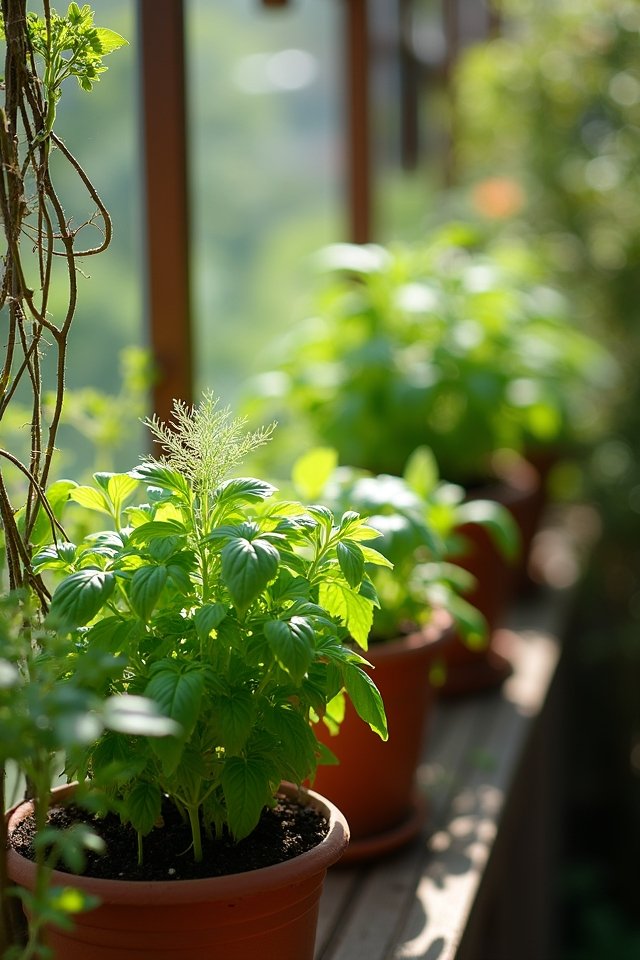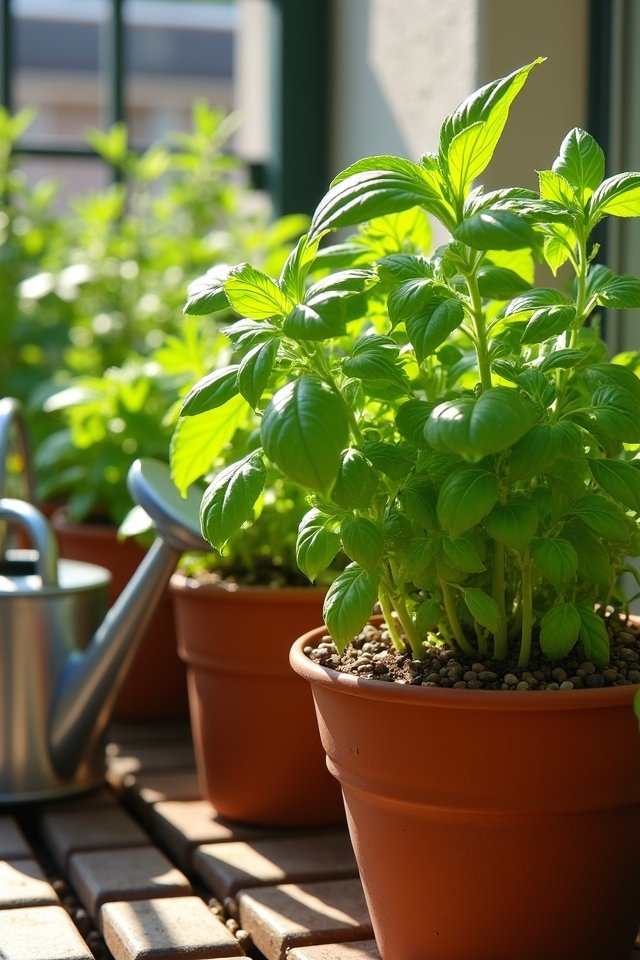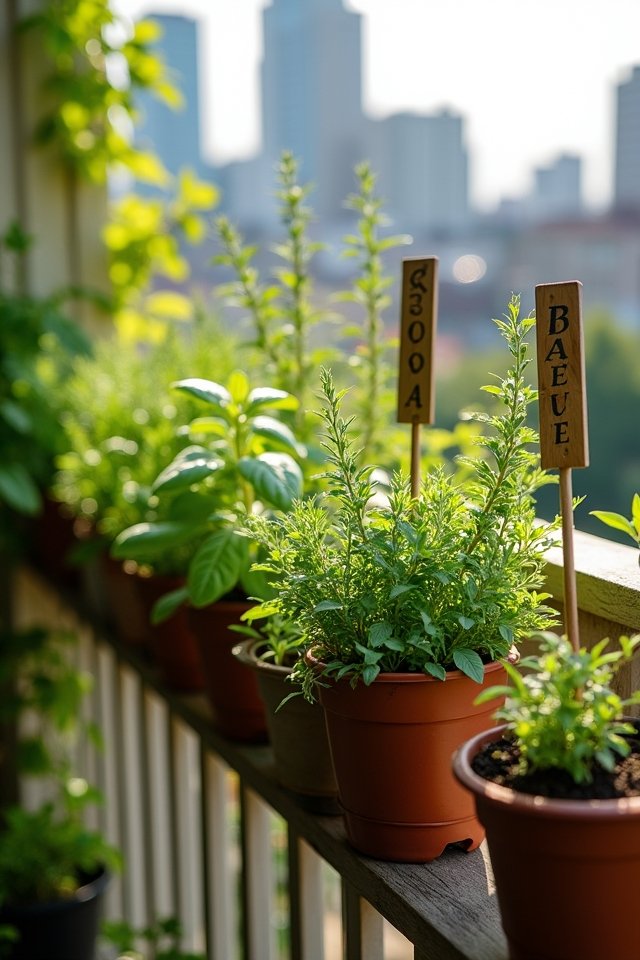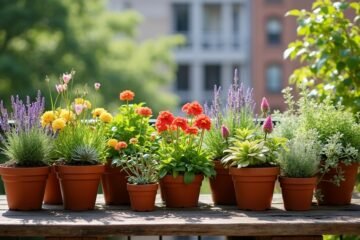Want a fragrant herb paradise on your balcony? Start by picking herbs like cheerful basil for delicious pesto and zesty rosemary for freshly baked bread! Choose colorful containers—think cute teacups or sleek metal pots—that fit your herbs’ sizes. Don’t forget drainage! Position them in sunny spots, getting at least six hours of light. Water them in the morning, use organic fertilizers, and keep an eye out for pesky bugs. Curious for more tips to elevate your green space?
Choose the Right Herbs for Your Balcony

When you’re planning your balcony herb garden, take a moment to think about what herb flavors tickle your taste buds! Do you dream of a zesty basil pesto or savory rosemary bread? These herbs not only elevate your culinary uses but also fill your space with delightful aromatic benefits. Imagine snipping fresh mint for a rejuvenating mojito or thyme to add depth to a stew! Choosing the right herbs transforms your cooking into a gourmet experience that’ll have friends begging for your secrets. Consider how well they’ll flourish in containers while basking in sunshine, too. So, stir up your creativity, and pick a mix that’ll make your culinary heart sing! Why settle for plain when you can have an herb symphony?
Select Suitable Containers

Selecting the right containers for your balcony herb garden is like choosing the perfect outfit—you want something stylish, functional, and that fits just right! Think about container materials first; terracotta offers a rustic charm, while sleek metal adds a modern flair. You can even get creative with recycled items—old teacups, anyone? Next, consider container sizes. Small herbs like chives thrive in a cozy pot, but larger ones like rosemary need more room to spread their roots. Group different sizes together for a visually stunning effect! Don’t forget to balance aesthetics with practicality—drainage holes are essential, just like that trusty pair of shoes! So, mix and match to create an inviting herb paradise that looks as good as it grows!
Ensure Proper Drainage

A well-draining pot is like a superhero for your herbs, swooping in to save them from drowning! Without proper drainage, your herbs could face root rot and end up sad and droopy. To guarantee your balcony garden thrives, consider these innovative drainage techniques and container materials:
- Choose pots with drainage holes – These little gaps are lifesavers!
- Use gritty mixes – Products with perlite or sand help moisture escape while keeping roots happy.
- Get creative with containers – Terracotta or ceramic pots breathe better than plastic, offering excellent drainage.
- Elevate your pots – Placing them on pot feet allows excess water to flow freely.
With these tips, you’ll have flourishing herbs that are resilient and vibrant!
Optimize Sunlight Exposure

Sunlight is the superstar of your balcony herb garden, turning your little green wonders into vibrant, aromatic treasures! To harness its power, pay close attention to sunlight angles. Position your pots where they bask in direct light for at least six hours daily. South-facing spots are fantastic—think of them as your herbs’ favorite beach!
However, don’t forget shade considerations! If your balcony gets morning sun but afternoon shade, opt for sun-loving herbs like basil and rosemary. On the other hand, mint and chives thrive in partly shaded areas. Use clever plant arrangements: taller plants can act like friendly sunshields for their shorter mates! Celebrate the dance of sunlight and shadows, and let your balcony blossom vibrantly!
Water Wisely

While you could drown your herbs in water like a well-meaning but misguided gardener, a wise watering routine keeps them flourishing instead! Adopt innovative techniques for ideal moisture retention. Here are a few tips to help you achieve herb happiness:
- Use drip irrigation: This method delivers water directly to the roots, preventing waterlogging.
- Water in the morning: Early drinkers absorb nutrients better, enhancing growth and flavor!
- Check the soil: Stick your finger in the soil; if it’s dry, give your herbs a drink!
- Mulch wisely: Adding organic mulch helps keep the moisture in, while your herbs bask in sunshine!
With these simple strategies, your herbs will thrive, boasting vibrant colors and mouthwatering flavors! Enjoy the journey!
Fertilize for Healthy Growth

Fertilizing your herbs might just be the secret ingredient to a lush, flavorful garden! Imagine vibrant basil leaves bursting with flavor and robust rosemary thriving in their pots. To achieve this, consider organic fertilizers; they’re like a warm hug for your plants! You can use composted materials or look for well-balanced organic options that feed the soil and your herbs. Liquid nutrients are another game-changer; they work faster and can be easily absorbed. Just mix them with water and watch your plants soak it up! Aim to fertilize every few weeks during the growing season, and don’t skimp—those herbs deserve every drop of goodness. Soon, you’ll be plucking fresh, delicious leaves like a pro! Isn’t that exciting?
Monitor for Pests and Diseases

Your vibrant herb garden isn’t just a feast for the eyes; it’s a mini ecosystem bustling with life! To keep it thriving, you need to monitor for pests and diseases. Identifying trouble early can save your herbs from an untimely fate.
Here are some essential tips:
- Inspect Weekly: Check leaves for holes or discoloration, much like a detective hunting for clues.
- Learn Pest Identification: Familiarize yourself with common offenders like aphids and whiteflies.
- Promote Disease Prevention: Rotate your herbs, and keep them well-spaced to improve airflow.
- Natural Remedies: Use neem oil or insecticidal soap—your garden’s superhero against pests!
Keep your herbs healthy and watch them flourish!
Frequently Asked Questions
Can I Grow Herbs Indoors Instead of on a Balcony?
Absolutely, you can grow herbs indoors instead of on a balcony! Indoor gardening offers a delightful way to nurture herb varieties like basil, parsley, and mint. Just think—your kitchen could be a mini herb haven! With the right light and water, these plants thrive, filling your space with fresh aromas. Why not try a windowsill herb garden? It’s like having a breath of nature right at home! Your culinary creations will thank you!
How Much Space Do Herbs Need to Thrive?
Herbs love their space, just like we do! Depending on the type, most herbs need at least six inches between each plant. Go for containers at least 12 inches deep and wide for happy roots to spread out. Picture basil thriving like a little green superstar among its friends. A crowded pot’s like a packed subway—nobody enjoys that! So, give your herbs room to dance and flourish in their cozy homes!
Are There Herbs That Attract Beneficial Insects?
You’ll love how certain herb varieties can attract beneficial insects. Think about planting basil and fennel; their fragrant blooms draw ladybugs and lacewings, nature’s pest controllers! Isn’t that brilliant? While you’re at it, add some dill, too—it’s a magnet for pollinators! Imagine your garden buzzing with activity and life! It’s like a mini nature show right outside your door. So, why not let your herbs be a charming insect hotel?
When Is the Best Time to Harvest My Herbs?
The best time to harvest your herbs is when they’re bursting with flavor and their leaves are vibrant. Generally, you’ll want to snip them right before they bloom, which signals peak growth. Think of it like catching fireworks before they fade! For example, basil’s at its height in late summer, while parsley loves the spring! So keep an eye on that harvest timing, and enjoy the aromatic symphony of fresh herbs!
Can I Use Kitchen Scraps to Grow Herbs?
Absolutely, you can use kitchen scraps for herb propagation! Imagine this: your leftover basil stems sprouting into vibrant new plants. It’s like magic! Start kitchen composting by placing herb trimmings in water for a few weeks. Soon, you’ll see roots forming! Just think, you’re turning trash into treasure. Use those little bits and watch them thrive! Isn’t it thrilling to nurture life from leftovers? You can be the hero of your kitchen garden!


